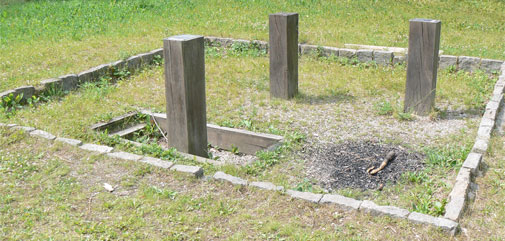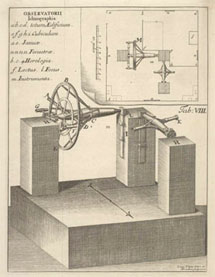Observatorium Tusculanum
In 1681 Ole Rømer set up an observatory in the Round Tower, which he later became the director for in 1686. However, the Round Tower was right next door to Trinity Church (Trinitatis Kirke), and the ringing of the church bells disturbed his observations.
He also fitted out an observatory in his home in Kannikestræde, but even though he sawed a clever notch in the opposite neighbour’s roof, he was still unable to see the stars when they were low. He therefore used the summer of 1704 to build a country observatory far from the capital’s bustle and noise on the Bartholin family’s land at Vridsløsemagle.
He called it the Observatorium Tusculanum and in letters he expressed his great joy at finally having his own observatory – it had been his greatest desire for many years. By building his own observatory, he could design it exactly as he wanted. In the observatory was his own invention, a meridian circle. With it he could accurately read the position of the stars in the sky.

Observatorium Tusculanum today. After Ole Rømer’s death in 1710 the observatory collapsed due to the lack of maintenance. Around the ear 1716-1717 the instruments were moved to the observatory in the Round Tower. The remains of the observatory were rediscovered in 1978 after several attempts.
Triduum – three days in October
In 1706 Ole Rømer made a series of observations from the Observatorium Tusculanum, which represent the most exciting and mysterious part of his astronomical work. Over three days (Latin: Triduum) from the 20 to the 23 October he and at least two assistants registered all the transits of all fixed stars and planets. His publication of the Triduum givers the position of 88 stars, based on approximately 250 observations.
These observations, in contrast to most of his work, were not lost in the fire in 1728. This is because Ole Rømer was so pleased with them that had at total of five copies made of them. He described them as "my astronomical observations, which have always esteemed above everything else I have owned in the World."
But what was it that Ole Rømer discovered, or thought he discovered, those three days in October 1706? Was it the stellar parallax, which is commonly assumed? If that was the case, he had once and for all proven the heliostatic worldview that all astronomers at that time were convinced, but no one up to that point had managed to deliver conclusive evidence for.
Other possibilities, however, present themselves. Perhaps Ole Rømer managed to observe the phenomena aberration, or perhaps he came so far that he discovered the proper motion of stars, that is the fact that our solar system is moving through the Milky Way? Future Rømer research should clarify this – the old astronomer still holds many mysteries.
 Model of the Observatorium Tusculanum.
Model of the Observatorium Tusculanum.
Meridian Circle
 The Meridian Circle set up in the Observatorium Tusculanum. Note the three pillars. The observatory’s floor plan is seen in the top right.
The Meridian Circle set up in the Observatorium Tusculanum. Note the three pillars. The observatory’s floor plan is seen in the top right.
Finds from the excavation
 Finds from the excavation of the Observatorium Tusculanum:
Finds from the excavation of the Observatorium Tusculanum:
2: Brass knob, perhaps from the instrument.
3: Fragment of a study for a lens.
4: Belt buckle with a Russian double-headed eagle.
5: A stylus point.
6: Fragments of brass plates.
